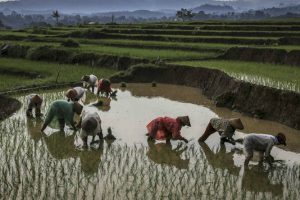The first hybrid rice varieties developed in sub-Saharan Africa are yielding up to four times more than other improved varieties, say scientists, who are using web-based tools to identify the right climate conditions to maximise harvests.
The 15 hybrids, bred in Kenya and Tanzania, are also resistant to diseases and the high temperatures found in Kenya’s western Lake Region and coastal areas.
Local farmers have always depended on imported hybrid rice varieties, particularly from Asia, which sometimes do not adapt well to conditions in sub-Saharan Africa.
As the climate changes and arable land shrinks under population pressure, experts say more innovative ways are needed to produce food.
It is projected that Africa’s food deficit will increase to 60-million tonnes by 2020 if no action is taken, according to the Alliance for a Green Revolution in Africa (Agra).
Joe DeVries, the director of an Agra programme to strengthen Africa’s seed systems, said productivity on the continent is limited by the fact that farmers have a narrow choice of improved varieties.
“Most of them [are] planting varieties that were released more than 30 years ago,” he said.
Denis Kyetere, the executive director of the African Agricultural Technology Foundation (AATF), which has developed the new hybrids in a public-private partnership, said hybrid technology revolutionised rice production in Asia, especially in China.
Asia’s productivity dramatically increased from an average of 1.89 tonnes a hectare in 1949 to 6.71 tonnes a hectare in 2012.
“With this technology, we look forward to Africa being able to feed Africa,” said Kayode Sanni, AATF’s project manager for rice. In 2014, Africa imported 12-million tonnes of rice, mostly from Asia.
The AATF, in collaboration with a private firm, Hybrids East Africa, has so far developed 140 hybrid rice vari- eties using African parent lines.
Of these, 15 — each yielding seven to 10 tonnes a hectare — have been presented to the Kenya Plant Health Inspectorate Service (Kephis) for national performance trials.
A partner in the hybrid rice project, aWare Inc, based in the United States, has developed web-based tools that allow scientists to determine when and where to conduct breeding, seed multiplication and seed production to take advantage of the best climatic conditions.
Improved inbred rice varieties, such as the New Rice for Africa lines, are already in use on African farms.
With this method, two different parent varieties are crossbred and their offspring are selected during several cycles of self-pollination, or inbreeding, to get the desired result.
The end product has the ability to reproduce itself through self-pollination because the rice plant flowers contain both the male and female organs.
With hybrid varieties, the parent plants are crossed separately with new varieties and the offspring from those crosses are united to produce a first-generation hybrid seed, which performs better than both parents. The process is repeated each time.
Currently, the average yield of inbred rice varieties in sub-Saharan Africa is 2.3 tonnes a hectare. But, in trials, some of the new hybrids have produced between seven and 10 tonnes a hectare, said Sanni, more than the breeders had hoped for.
“I think it is a tremendous breakthrough,” he added.
One potential problem is that seeds harvested from hybrid plants are not recommended for replanting because their superior performance is lost because of genetic separation, resulting in a lower yield.
That means ideally farmers cannot save seed from their harvest to plant again and seed companies must cross the parent materials every season to produce new hybrid seed for planting.
“This has always been a setback, particularly for farmers who cannot afford the higher prices of hybrid seeds. But, through this project, we have developed an innovative way of helping the poor farmers so that they can borrow the seed and pay [it] back only after harvest,” said John Mann, the managing director for Afritec Seeds, which is testing more than 100 hybrid varieties under the AATF’s Breeding by Design project.
Although farmers will have to buy seeds each time they plant, the extra profit from the hybrids’ higher yield is expected to be far higher than the cost of the seeds, said Sanni.
Apart from Egypt, which has been producing hybrid rice on a commercial scale for more than a decade, no other African country had succeeded in developing its own local hybrid rice.
Egyptian farmers have improved the country’s average rice production to almost 10 tonnes a hectare, a feat praised by the United Nations Food and Agriculture Organisation and others.
Farmers who are participating in the trials in East Africa are eagerly waiting for the hybrid seeds to be officially released for commercial use, probably in less than a year, after two seasons of trials by Kephis.
“We have already set aside money to buy the new breeds,” said Charles Wawo, a rice farmer and chairperson of the Ahero Irrigation Scheme Multipurpose Cooperative Society in Kisumu County in western Kenya.
Kenya and Tanzania will be the first beneficiaries of the new hybrid varieties. Trials will then be rolled out in other countries in East, West and Southern Africa, Sanni said. — Reuters

